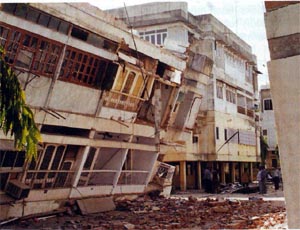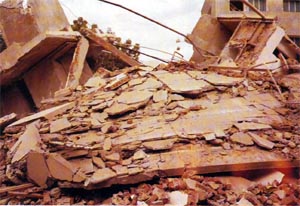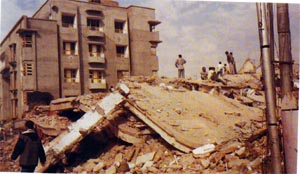Dec 26, 2025
Dec 26, 2025
Our country is on a fast track of development. The population pressure demands rapid strides in housing sector. There has been a tendency to develop housing colonies as close to city centre as possible. Consequently now there is a shortage of land. Take Mumbai for example. Land is costlier than life there. Concept of Navi Mumbai did come, but it seems every one wants a flat at Colaba only. Naturally buildings have to grow skywards. More human beings mean more hospitals, more schools and more shopping malls. Now even these structures are rising more towards the sky than earlier. Are we aware of possibilities of killer earthquakes in this sprawling country of ours? Do we have a roadmap to seismic safety? These are some questions that often haunt the minds of geologists, and earthquake engineers. We shall try to analyze them and seek answers. Some of the biggest earthquakes in the world have occurred in the subcontinent and we have learnt some major lessons in the science of seismology and earthquake engineering. How serious were the British geologists and engineers about the earthquake problem and safety in India can be understood by several example. When an earthquake shook Kutch in 1819 it was first time found and established that the tremors were due to a subterranean fault. It was then also establish that the buildings on rocky foundations remain safe while those on the alluvium shake like a fig leaf.
Necessity is the mother of inventions goes the saying. True to this after the Baluchistan earthquake 1831, earthquake resistant buildings were constructed for the first time for the officers of the Railways at Quetta. The effort paid dividends, as these were the only houses that remained unruffled during the 1835 earthquake at Quetta. The 1835 earthquake was quite devastating. It took toll of nearly 25,000 lives. Taking cue from the earthquake safe houses built by the Railways, earthquake safety codes were refined and developed for the army and civil authorities at Quetta.
 Professor S.K. Jain of IIT, Kanpur, has drawn attention to 'safe housing' through his papers published in various national and international forums. In one of his papers published in April issue of Current Science he says that collapse of 135 modern, multistory buildings in Ahmedabad, 245 km from the epicentre clearly shows that Indian civil construction practices require much to be desired with respect to seismic safety. Comparing the problem with South America, he says that earthquake safe houses at Peru which is rocked frequently by earthquakes are within the reach of only the higher echelons of society. Unfortunately in India he says no one is safe with the type of so called earthquake safe houses.
Professor S.K. Jain of IIT, Kanpur, has drawn attention to 'safe housing' through his papers published in various national and international forums. In one of his papers published in April issue of Current Science he says that collapse of 135 modern, multistory buildings in Ahmedabad, 245 km from the epicentre clearly shows that Indian civil construction practices require much to be desired with respect to seismic safety. Comparing the problem with South America, he says that earthquake safe houses at Peru which is rocked frequently by earthquakes are within the reach of only the higher echelons of society. Unfortunately in India he says no one is safe with the type of so called earthquake safe houses.
 Professor Jain further elaborates damages during the 2001 Bhuj earthquake and Tsunami of 2004 have left ample scars on the soils of Gujarat and Andamans. He says that about 6000 school buildings were constructed in Gujarat between 1999 and 2000. During the earthquake on 26 January 2001, more than three quarters of these school buildings either collapsed or were seriously damaged. School buildings and hospitals are two places where utmost care is taken in developed countries. Perhaps lives are more precious there than material costs! Andamans fall in high seismic risk zone. Austin Creek bridge connecting North Andaman with Middle Andaman was constructed in 2002. Seismic codes were set aside, this negligence was pointed out, yet the authorities did not bother. The bridge became non-functional after the tsunami-genic Sumatran earthquake of 2004.
Professor Jain further elaborates damages during the 2001 Bhuj earthquake and Tsunami of 2004 have left ample scars on the soils of Gujarat and Andamans. He says that about 6000 school buildings were constructed in Gujarat between 1999 and 2000. During the earthquake on 26 January 2001, more than three quarters of these school buildings either collapsed or were seriously damaged. School buildings and hospitals are two places where utmost care is taken in developed countries. Perhaps lives are more precious there than material costs! Andamans fall in high seismic risk zone. Austin Creek bridge connecting North Andaman with Middle Andaman was constructed in 2002. Seismic codes were set aside, this negligence was pointed out, yet the authorities did not bother. The bridge became non-functional after the tsunami-genic Sumatran earthquake of 2004.
 As per the structural engineers the seismic codes are often flouted, falls certificates are obtained by greasing the palms of the authorities and sky-scrappers are built. Immediately after the earthquakes the state and the central governments announce measures to be taken to safeguard the future. However, the tall promises are never kept and a repeat earthquake proves the myth.
As per the structural engineers the seismic codes are often flouted, falls certificates are obtained by greasing the palms of the authorities and sky-scrappers are built. Immediately after the earthquakes the state and the central governments announce measures to be taken to safeguard the future. However, the tall promises are never kept and a repeat earthquake proves the myth.
A question thus emerges, what is the way out? If by a magic wand all the buildings and structures become earthquake resistant the problem would be over. Is it possible? To some extent it is. Certain precautions are mandatory in the buildings code. For example, a hospital building or a school building where there is a larger congregation of people precise information about past ground motion and intensity of earthquakes that have occurred within a radius of 300 km has to be collected. In developed countries this is a normal practice. But in this part of the sub-continent, safety of school buildings and hospitals is perhaps the last priority. We have recent examples of 400 plus children perishing in Anjar during Bhuj earthquake of 2001 and another 400 children were crushed alive in Muzzaffarabad in Pakistan during 2005 earthquake.
Examples of such earthquake generated tragedies are well recorded in the annuls of the Geological Survey of India (GSI). The first semi-scientific record in India is that of Delhi-Agra earthquake of July 15, 1505. A major earthquake again rocked Delhi on July 15, 1720. It was 22nd Ramzan and people had assembled in mosques to offer prayers. Many people lost their lives in Shahjenabad (New Delhi) and Old Delhi. After this Kaifikhan recorded in 'Muntakhabul-Ul-Lulab' that similar shocks continued to terrorize Delhi for 40 days.
On September 1, 1803, the Mathura-Delhi area was rocked at 3AM. Mathura suffered the maximum damage. Open fissures were formed on the ground and water gushed out with force. Delhi was also severely affected and top portion of famous Kutubminar came tumbling down.
The earthquake on June 16, 1819, in Kutch was no less devastating. Its intensity was such that eight kilometers north of Sindri, in the Rann of Kutch a three metre high and 65 km long ridge of clay and shell was formed. The local population named it 'Allah Bund'. Bhuj a major town then, had perished in this earthquake. About 2000 people lost their lives. This earthquake took a toll of 500 lives during a religious congregation in a mosque at Ahmedabad. So powerful was the earthquake that shocks were felt in the far north at Sultanpur, Jaunpur, Mirzapur and Kolkata.
Thomas Oldham of Geological Survey Of India calculated the intensity of this earthquake on Richter scale as 8.3. The gravity of the situation can be understood by the fact that an earthquake beyond the intensity 8 causes total devastation.
Despite such precise information available we have not drawn any concrete roadmap to safeguard our lives. Immediately after an earthquake teams after teams of 'experts' visit the affected areas and describe the devastation like the 'five blind men' describing an elephant. Each expert has his own notions of safety and plans for future safety. Naturally there are clash of views and finally the government accepts some recommendations and does implement some of them. However, the masses remain deprived of the provisions made by the government, because there is hardly any awareness amongst the masses.
The recent two earthquakes of 2001 (Bhuj) and 2005 (Kashmir) have been an eye opener and the experts have aired their views on what should be done for future safety. It is a tendency to gather the expertise from developed countries. No harm as long as it is for the betterment of our own people. Lorna Prieta in California is prone to frequent earthquakes. Famous for historical buildings and churches the government and the society decided to go for large scale retrofitting after a devastating earthquake in 1989. The technique saved hundreds of lives and scores of building too. Thereafter the term retrofitting came to stay for the earthquake safety of buildings in India. But before going for that one has to think 'is it really viable', 'where do we need it and where we can avoid it'.
Retrofitting is a specialized technique. Apart from skill it involves huge costs. Before embarking upon the project one has to evaluate the cost-benefit ratio. For example for a heritage building retrofitting may be extremely beneficial, but for comparatively recent constructions dismantling the present structure and reconstructing it with earthquake safe designs may work out cheaper, says Prof Jain.
Construction activity in our country, especially in the urban housing sector has been following age old techniques. There are vast areas that have not experienced a severe earthquake in the recent past. Buyers of apartments in the high rise buildings of Ahmedabad learnt the hard way about the primitive techniques. Their houses crumbled like a pack of cards during the Bhuj earthquake of 2001.
People of Gujarat and Kashmir have become quite aware about the significance of earthquake proofing of houses. But alas, people in the rest of the country either hoodwink themselves or the government and avoid the mandatory aseismic designs. Therefore a massive awareness drive is required to enlighten the masses across the country. It is time that big builders are brought under a confederation which keeps updating their knowledge about the advantages of earthquake resistant houses.
Rules for earthquake safe housing have been implemented, but down the ladder slackness is always there. Issuing fake certificates for earthquake safe houses has to be made a cognizable offence wherein the builder and the municipal authority both should be made parties.
Commonly an Indian house builder avoids engaging an architect what to think of a structural engineer. For him all in one is the mason. There is a strong need for creating a force of technicians and skilled hands guided by structural engineers so that the civil constructions are made earthquake proof.
Prof Jain says that in the field of medicine it is criminal offense for any one without degrees of medicine to practice it. Same applies to law as well. However, in case of civil construction there are no restrictions and there are several 'self styled' experts in the field. Such practice has to be stopped. The best way is to educate the masses. Like literate people generally avoid quacks for treatment, same way they will stop going to engineer quacks.
Implementation of regulations is very necessary. A person without a valid driving license if caught is penalized heavily. Whereas a person hoodwinking the rules or the other keeping his eyes shut while the rules are not followed go scot free.
These days we are reading a lot about seismic micro-zonation. Well that is a long drawn process and it is very much needed especially in the metros or the cities where high rise buildings are coming up in bulk. But unless precise details of anticipated ground shaking are available at a given spot and measures taken in the construction to counter that, a mere map will be of any use. Thus seismic zonation studies need to be implemented in letter and spirit.
In a nut shell a tighter control and monitoring is required on part of the government in the civil constructions Vis a Vis earthquakes and a closer cooperation is needed from the builders and the like.
J.A. Dunn of GSI wrote in Memoir 73 of GSI in 1939, after completion of the Nepal-Bihar earthquake of 1934:
"Leprosy is not a common disease, but the medical profession has done its utmost to eradicate it for the sake of humanity. Great earthquakes are not part of the earth's crust, but it should be our duty to do all that we can to reduce its effects. Unless this matter is looked upon in a broad way, posterity may yet look back upon our short-sightedness with regret".
What Dunn wrote 68 years ago holds true even now. The science of seismology and structural engineering has grown in leaps and bounds in these years. Now at least let us have a road map to seismic safety.
17-Jun-2007
More by : V. K. Joshi (Bijji)

|
i have read ur matter can u suggest any remedy aboudt fissured rock in navi mumbai to resist the future earthequake |